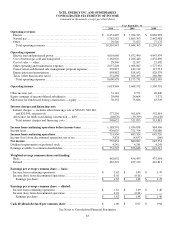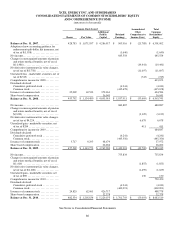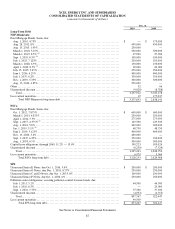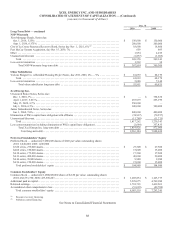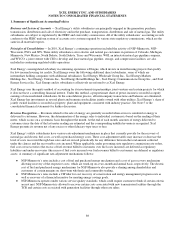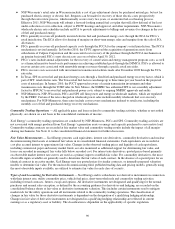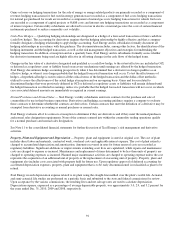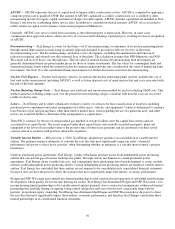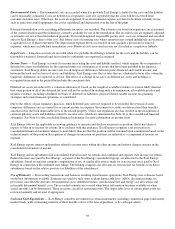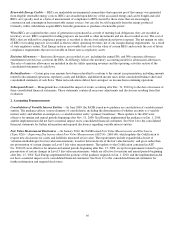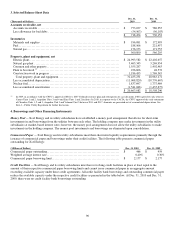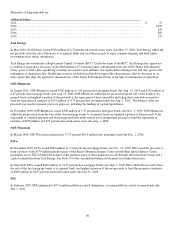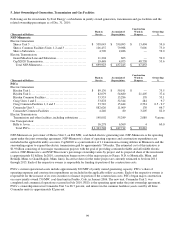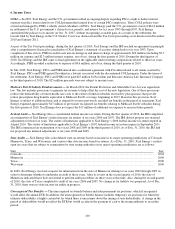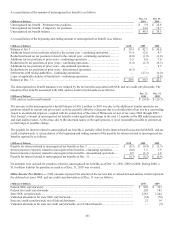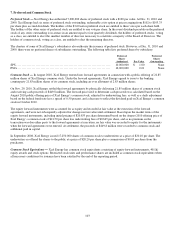Xcel Energy 2010 Annual Report Download - page 103
Download and view the complete annual report
Please find page 103 of the 2010 Xcel Energy annual report below. You can navigate through the pages in the report by either clicking on the pages listed below, or by using the keyword search tool below to find specific information within the annual report.93
Environmental Costs — Environmental costs are recorded when it is probable Xcel Energy is liable for the costs and the liability
can be reasonably estimated. Costs are deferred as a regulatory asset if it is probable that the costs will be recovered from
customers in future rates. Otherwise, the costs are expensed. If an environmental expense is related to facilities currently in use,
such as emission-control equipment, the cost is capitalized and depreciated over the life of the plant.
Estimated remediation costs, excluding inflationary increases, are recorded. The estimates are based on experience, an assessment
of the current situation and the technology currently available for use in the remediation. The recorded costs are regularly adjusted
as estimates are revised and remediation proceeds. If several designated responsible parties exist, costs are estimated and recorded
only for Xcel Energy’s share of the cost. Any future costs of restoring sites where operation may extend indefinitely are treated as
a capitalized cost of plant retirement. The depreciation expense levels recoverable in rates include a provision for removal
expenses, which may include final remediation costs. Removal costs recovered in rates are classified as a regulatory liability.
Legal Costs — Litigation accruals are recorded when it is probable Xcel Energy is liable for the costs and the liability can be
reasonably estimated. External legal fees related to settlements are expensed as incurred.
Income Taxes — Xcel Energy accounts for income taxes using the asset and liability method, which requires the recognition of
deferred tax assets and liabilities for the expected future tax consequences of events that have been included in the financial
statements. Xcel Energy defers income taxes for all temporary differences between pretax financial and taxable income, and
between the book and tax bases of assets and liabilities. Xcel Energy uses the tax rates that are scheduled to be in effect when the
temporary differences are expected to reverse. The effect of a change in tax rates on deferred tax assets and liabilities is
recognized in income in the period that includes the enactment date.
Deferred tax assets are reduced by a valuation allowance if, based on the weight of available evidence, it is more likely than not
that some portion or all of the deferred tax asset will not be realized. In making such a determination, all available positive and
negative evidence, including scheduled reversals of deferred tax liabilities, projected future taxable income, tax planning
strategies and recent financial operations, is considered.
Due to the effects of past regulatory practices, when deferred taxes were not required to be recorded, the reversal of some
temporary differences are accounted for as current income tax expense. Investment tax credits are deferred and their benefits
amortized over the book depreciable lives of the related property. Utility rate regulation also has resulted in the recognition of
certain regulatory assets and liabilities related to income taxes, which are summarized in Note 16 to the consolidated financial
statements. See Note 6 to the consolidated financial statements for more information on income taxes.
Xcel Energy follows the applicable accounting guidance to measure and disclose uncertain tax positions that it has taken or
expects to take in its income tax returns. In accordance with this guidance, Xcel Energy recognizes a tax position in its
consolidated financial statements when it is more likely than not that the position will be sustained upon examination based on the
technical merits of the position. Recognition of changes in uncertain tax positions are reflected as a component of income tax
expense.
Xcel Energy reports interest and penalties related to income taxes within the other income and interest charges sections in the
consolidated statements of income.
Xcel Energy and its subsidiaries file consolidated federal income tax returns and combined and separate state income tax returns.
Federal income taxes paid by Xcel Energy, as parent of the Xcel Energy consolidated group, are allocated to the Xcel Energy
subsidiaries based on separate company computations of tax. A similar allocation is made for state income taxes paid by Xcel
Energy in connection with combined state filings. The holding company also allocates its own income tax benefits to its direct
subsidiaries based on the relative positive tax liabilities of the subsidiaries.
Use of Estimates — In recording transactions and balances resulting from business operations, Xcel Energy uses estimates based
on the best information available. Estimates are used for such items as plant depreciable lives, AROs, decommissioning, tax
provisions, uncollectible amounts, environmental costs, unbilled revenues, jurisdictional fuel and energy cost allocations and
actuarially determined benefit costs. The recorded estimates are revised when better information becomes available or when
actual amounts can be determined. Those revisions can affect operating results. The depreciable lives of certain plant assets are
reviewed annually and revised, if appropriate.
Cash and Cash Equivalents — Xcel Energy considers investments in certain instruments, including commercial paper and money
market funds, with a remaining maturity of three months or less at the time of purchase, to be cash equivalents.


